Experimental Investigation of Forming Forces in Frictional Stir Incremental Forming of Aluminum Alloy AA6061-T6
Abstract
:1. Introduction
2. Materials and Methods
2.1. Material Characterization
2.2. Experimental Setup
2.3. Experiments
3. Results and Discussion
4. Conclusions
- (1)
- Increasing the rotation speed has the main effect of reducing the forming forces.
- (2)
- In addition, the interaction between the different process parameters has a notable influence on these forces, especially the interaction between the feed rate and step size as discussed above.
- (3)
- The other parameter had a smaller effect compared with the rotation speed. Thus, controlling the tool rotation speed is an important issue in reducing the forming forces in SPIF.
Acknowledgments
Author Contributions
Conflicts of Interest
References
- Cao, T.; Lu, B.; Xu, D.; Zhang, H.; Chen, J.; Long, H.; Cao, J. An efficient method for thickness prediction in multi-pass incremental sheet forming. Int. J. Adv. Manuf. Technol. 2015, 77, 469–483. [Google Scholar] [CrossRef]
- Ingarao, G.; Di Lorenzo, R.; Micari, F. Sustainability issues in sheet metal forming processes: An overview. J. Clean. Prod. 2011, 19, 337–347. [Google Scholar] [CrossRef]
- Zhang, Q.; Xiao, F.; Guo, H.; Li, C.; Gao, L.; Guo, X.; Han, W.; Bondarev, A. Warm negative incremental forming of magnesium alloy AZ31 Sheet: New lubricating method. J. Mater. Process. Technol. 2010, 210, 323–329. [Google Scholar] [CrossRef]
- Ambrogio, G.; Filice, L.; Gagliardi, F. Formability of lightweight alloys by hot incremental sheet forming. Mater. Des. 2012, 34, 501–508. [Google Scholar] [CrossRef]
- Bao, W.; Chu, X.; Lin, S.; Gao, J. Experimental investigation on formability and microstructure of AZ31B alloy in electropulse-assisted incremental forming. Mater. Des. 2015, 87, 632–639. [Google Scholar] [CrossRef]
- Jeswiet, J.; Micari, F.; Hirt, G.; Bramley, A.; Duflou, J.; Allwood, J. Asymmetric single point incremental forming of sheet metal. CIRP Ann. Manuf. Technol. 2005, 54, 88–114. [Google Scholar] [CrossRef]
- Ambrogio, G.; De Napoli, L.; Filice, L.; Gagliardi, F.; Muzzupappa, M. Application of incremental forming process for high customised medical product manufacturing. J. Mater. Process. Technol. 2005, 162, 156–162. [Google Scholar] [CrossRef]
- Franzen, V.; Witulski, J.; Brosius, A.; Trompeter, M.; Tekkaya, A. Thermally sprayed coatings as effective tool surfaces in sheet metal forming applications. J. Therm. Spray Technol. 2011, 20, 939–947. [Google Scholar] [CrossRef]
- Astarita, A.; Carrino, L.; Durante, M.; Formisano, A.; Langella, A.; Minutolo, F.; Paradiso, V.; Squillace, A. Experimental study on the incremental forming of coated aluminum alloy sheets. Key Eng. Mater. 2014, 622–623, 398–405. [Google Scholar] [CrossRef]
- Xu, D.; Lu, B.; Cao, T.; Chen, J.; Long, H.; Cao, J. A comparative study on process potentials for frictional stir-and electric hot-assisted incremental sheet forming. Procedia Eng. 2014, 81, 2324–2329. [Google Scholar] [CrossRef]
- Li, C.; Jiang, S.; Zhang, K. Pulse current-assisted hot-forming of light metal alloy. Int. J. Adv. Manuf. Technol. 2012, 63, 931–938. [Google Scholar] [CrossRef]
- Asghar, J.; Reddy, N. Importance of tool configuration in incremental sheet metal forming of difficult to form materials using electro-plasticity. Lect. Notes Eng. Comput. Sci. 2013, 2206, 1734–1738. [Google Scholar]
- Duflou, J.; Tunckol, Y.; Szekeres, A.; Vanherck, P. Experimental study on force measurements for single point incremental forming. J. Mater. Process. Technol. 2007, 189, 65–72. [Google Scholar] [CrossRef]
- Ren, H.; Moser, N.; Zhang, Z.; Ndip-Agbor, E.; Smith, J.; Ehmann, K.F.; Cao, J. Effects of tool positions in accumulated double-sided incremental forming on part geometry. J. Manuf. Sci. Eng. 2015, 137. [Google Scholar] [CrossRef]
- Li, Y.; Liu, Z.; Lu, H.; Daniel, W.B.; Liu, S.; Meehan, P.A. Efficient force prediction for incremental sheet forming and experimental validation. Int. J. Adv. Manuf. Technol. 2014, 73, 571–587. [Google Scholar] [CrossRef]
- Ambrogio, G.; Filice, L.; Micari, F. A force measuring based strategy for failure prevention in incremental forming. J. Mater. Process. Technol. 2006, 177, 413–416. [Google Scholar] [CrossRef]
- Durante, M.; Formisano, A.; Langella, A.; Minutolo, F.M.C. The influence of tool rotation on an incremental forming process. J. Mater. Process. Technol. 2009, 209, 4621–4626. [Google Scholar] [CrossRef]
- Al-Ghamdi, K.A.; Hussain, G. Forming forces in incremental forming of a geometry with corner feature: Investigation into the effect of forming parameters using response surface approach. Int. J. Adv. Manuf. Technol. 2015, 76, 2185–2197. [Google Scholar] [CrossRef]
- Jeswiet, J.; Duflou, J.R.; Szekeres, A. Forces in single point and two point incremental forming. Adv. Mater. Res. 2005, 6–8, 449–456. [Google Scholar] [CrossRef]
- Duflou, J.R.; Szekeres, A.; Vanherck, P. Force measurements for single point incremental forming: An experimental study. Adv. Mater. Res. 2005, 6–8, 441–448. [Google Scholar] [CrossRef]
- Duflou, J.; Callebaut, B.; Verbert, J.; De Baerdemaeker, H. Laser assisted incremental forming: Formability and accuracy improvement. CIRP Ann. Manuf. Technol. 2007, 56, 273–276. [Google Scholar] [CrossRef]
- Duflou, J.; Callebaut, B.; Verbert, J.; De Baerdemaeker, H. Improved SPIF performance through dynamic local heating. Int. J. Mach. Tools Manuf. 2008, 48, 543–549. [Google Scholar] [CrossRef]
- Filice, L.; Ambrogio, G.; Micari, F. On-line control of single point incremental forming operations through punch force monitoring. CIRP Ann. Manuf. Technol. 2006, 55, 245–248. [Google Scholar] [CrossRef]
- Ambrogio, G.; Duflou, J.; Filice, L.; Aerens, R. Some considerations on force trends in Incremental Forming of different materials. AIP Conf. Proc. 2007, 907. [Google Scholar] [CrossRef]
- Aerens, R.; Eyckens, P.; Van Bael, A.; Duflou, J. Force prediction for single point incremental forming deduced from experimental and FEM observations. Int. J. Adv. Manuf. Technol. 2010, 46, 969–982. [Google Scholar] [CrossRef]
- Nee, A.Y. Handbook of Manufacturing Engineering and Technology; Springer: London, UK, 2015. [Google Scholar]
- Bagudanch, I.; Centeno, G.; Vallellano, C.; Garcia-Romeu, M. Forming force in single point incremental forming under different bending conditions. Procedia Eng. 2013, 63, 354–360. [Google Scholar] [CrossRef]
- Centeno, G.; Bagudanch, I.; Martínez-Donaire, A.; Garcia-Romeu, M.L.; Vallellano, C. Critical analysis of necking and fracture limit strains and forming forces in single-point incremental forming. Mater. Des. 2014, 63, 20–29. [Google Scholar] [CrossRef]
- Xu, D.; Wu, W.; Malhotra, R.; Chen, J.; Lu, B.; Cao, J. Mechanism investigation for the influence of tool rotation and laser surface texturing (LST) on formability in single point incremental forming. Int. J. Mach. Tools Manuf. 2013, 73, 37–46. [Google Scholar] [CrossRef]
- Palumbo, G.; Brandizzi, M. Experimental investigations on the single point incremental forming of a titanium alloy component combining static heating with high tool rotation speed. Mater. Des. 2012, 40, 43–51. [Google Scholar] [CrossRef]
- Hussain, G.; Gao, L.; Hayat, N.; Cui, Z.; Pang, Y.; Dar, N. Tool and lubrication for negative incremental forming of a commercially pure titanium sheet. J. Mater. Process. Technol. 2008, 203, 193–201. [Google Scholar] [CrossRef]
- Azevedo, N.G.; Farias, J.S.; Bastos, R.P.; Teixeira, P.; Davim, J.P.; de Sousa, R.J.A. Lubrication aspects during single point incremental forming for steel and aluminum materials. Int. J. Precis. Eng. Manuf. 2015, 16, 589–595. [Google Scholar] [CrossRef]
- Bahloul, R.; Arfa, H.; Salah, H.B. Application of response surface analysis and genetic algorithm for the optimization of single point incremental forming process. Key Eng. Mater. 2013, 554–557, 1265–1272. [Google Scholar] [CrossRef]
- Henrard, C.; Bouffioux, C.; Eyckens, P.; Sol, H.; Duflou, J.; Van Houtte, P.; Van Bael, A.; Duchene, L.; Habraken, A. Forming forces in single point incremental forming: Prediction by finite element simulations, validation and sensitivity. Comput. Mech. 2011, 47, 573–590. [Google Scholar] [CrossRef]
- Ziran, X.; Gao, L.; Hussain, G.; Cui, Z. The performance of flat end and hemispherical end tools in single-point incremental forming. Int. J. Adv. Manuf. Technol. 2010, 46, 1113–1118. [Google Scholar] [CrossRef]
- Martínez-Romero, O.; García-Romeu, M.L.; Olvera-Trejo, D.; Bagudanch, I.; Elías-Zúñiga, A. Tool dynamics during single point incremental forming process. Procedia Eng. 2014, 81, 2286–2291. [Google Scholar] [CrossRef]
- Li, Y.L.; Liu, Z.B.; Lu, H.B.; Daniel, W.; Meehan, P.A. Experimental study and efficient prediction on forming forces in incremental sheet forming. Adv. Mater. Res. 2014, 939, 313–321. [Google Scholar] [CrossRef]
- Hussain, G.; Gao, L. A novel method to test the thinning limits of sheet metals in negative incremental forming. Int. J. Mach. Tools Manuf. 2007, 47, 419–435. [Google Scholar] [CrossRef]
- Buffa, G.; Campanella, D.; Fratini, L. On the improvement of material formability in SPIF operation through tool stirring action. Int. J. Adv. Manuf. Technol. 2013, 66, 1343–1351. [Google Scholar] [CrossRef]
- Gologlu, C.; Sakarya, N. The effects of cutter path strategies on surface roughness of pocket milling of 1.2738 steel based on Taguchi method. J. Mater. Process. Technol. 2008, 206, 7–15. [Google Scholar] [CrossRef]
- Gaitonde, V.; Karnik, S.; Achyutha, B.; Siddeswarappa, B.; Davim, J.P. Predicting burr size in drilling of AISI 316L stainless steel using response surface analysis. Int. J. Mater. Prod. Technol. 2009, 35, 228–245. [Google Scholar] [CrossRef]
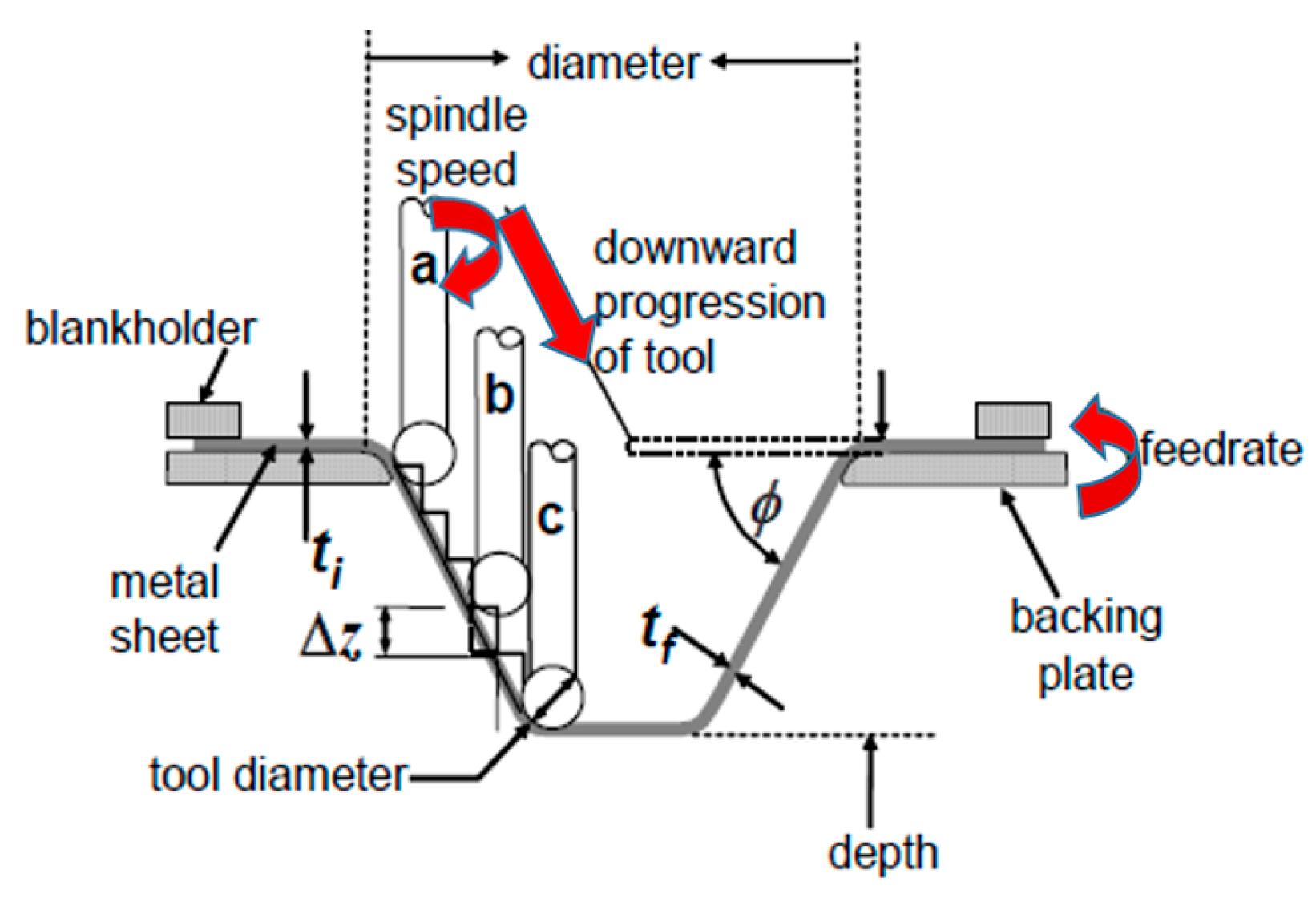


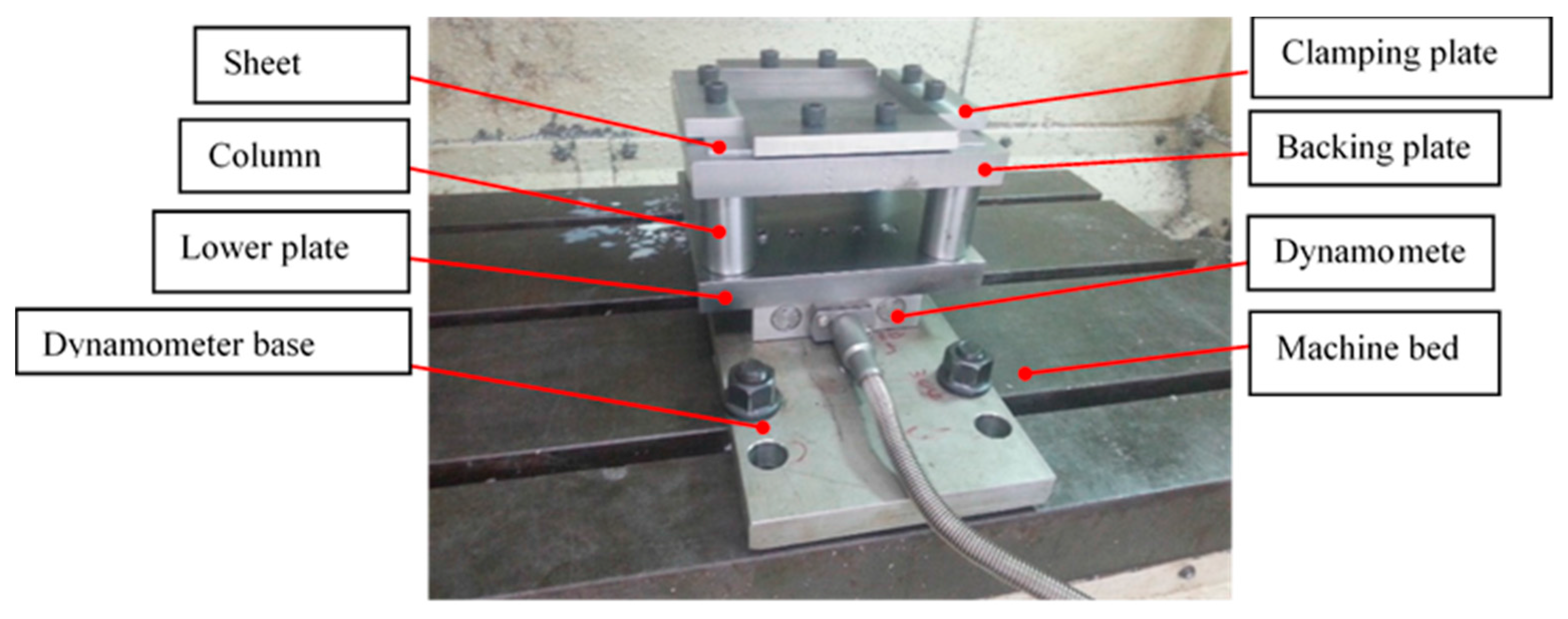
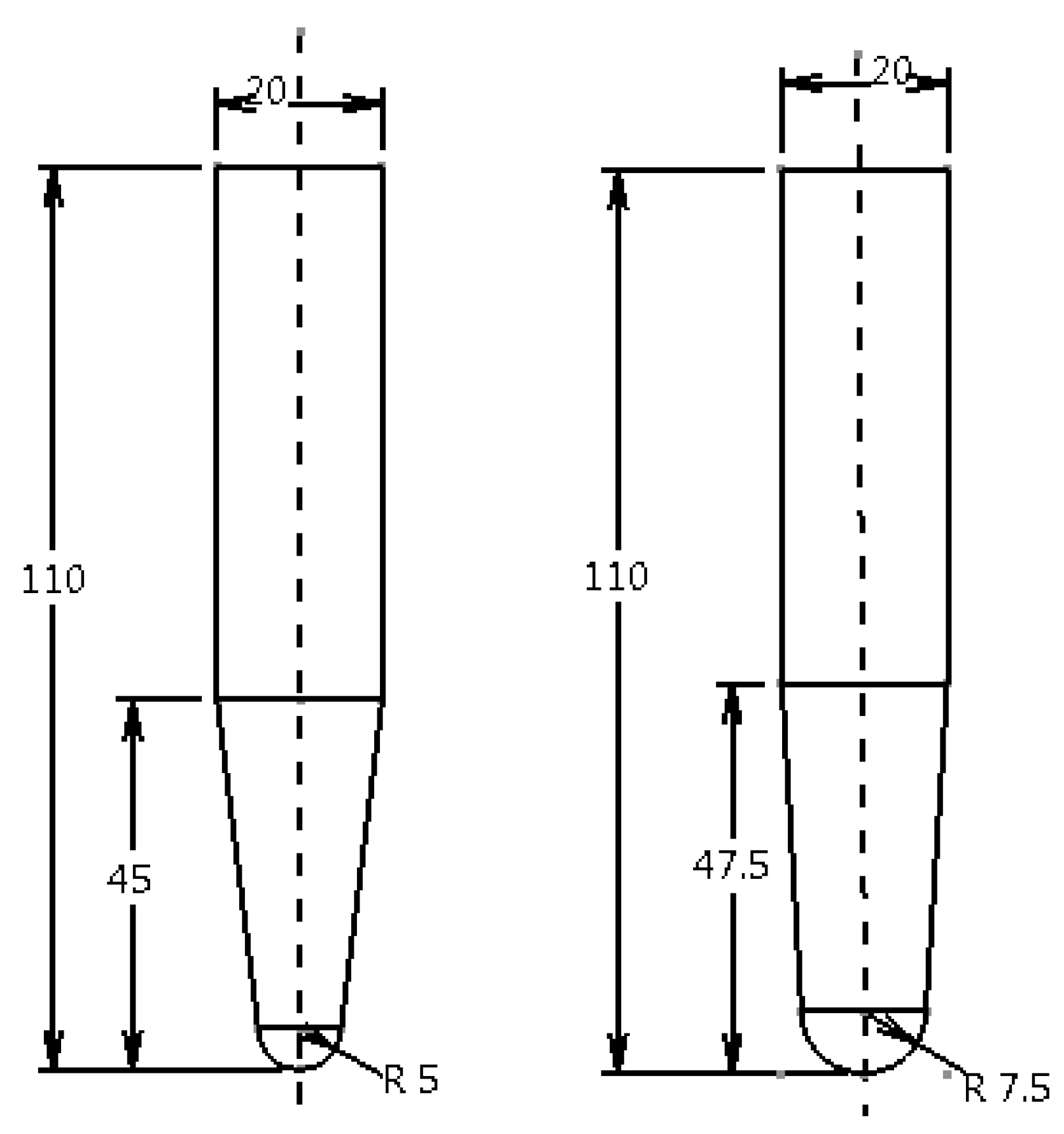
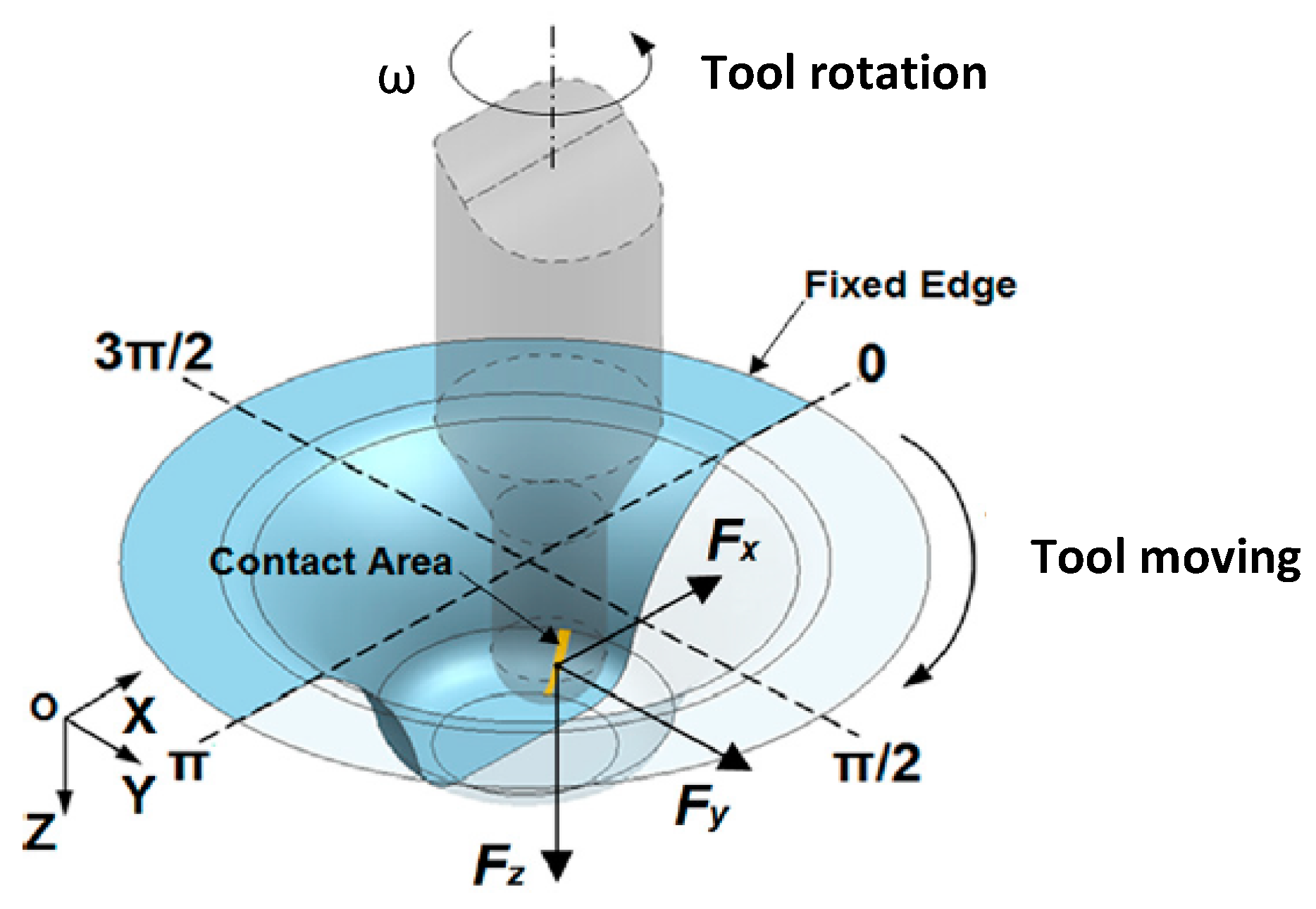
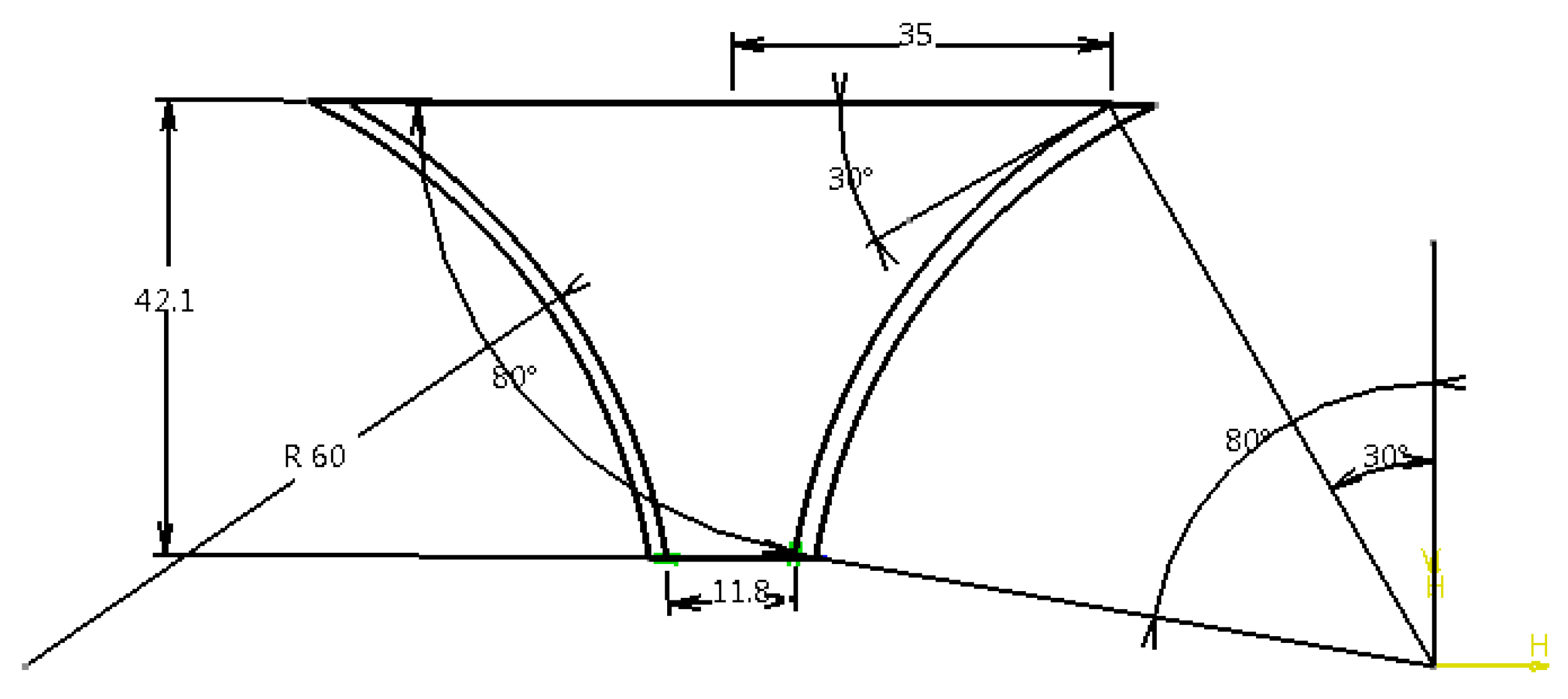



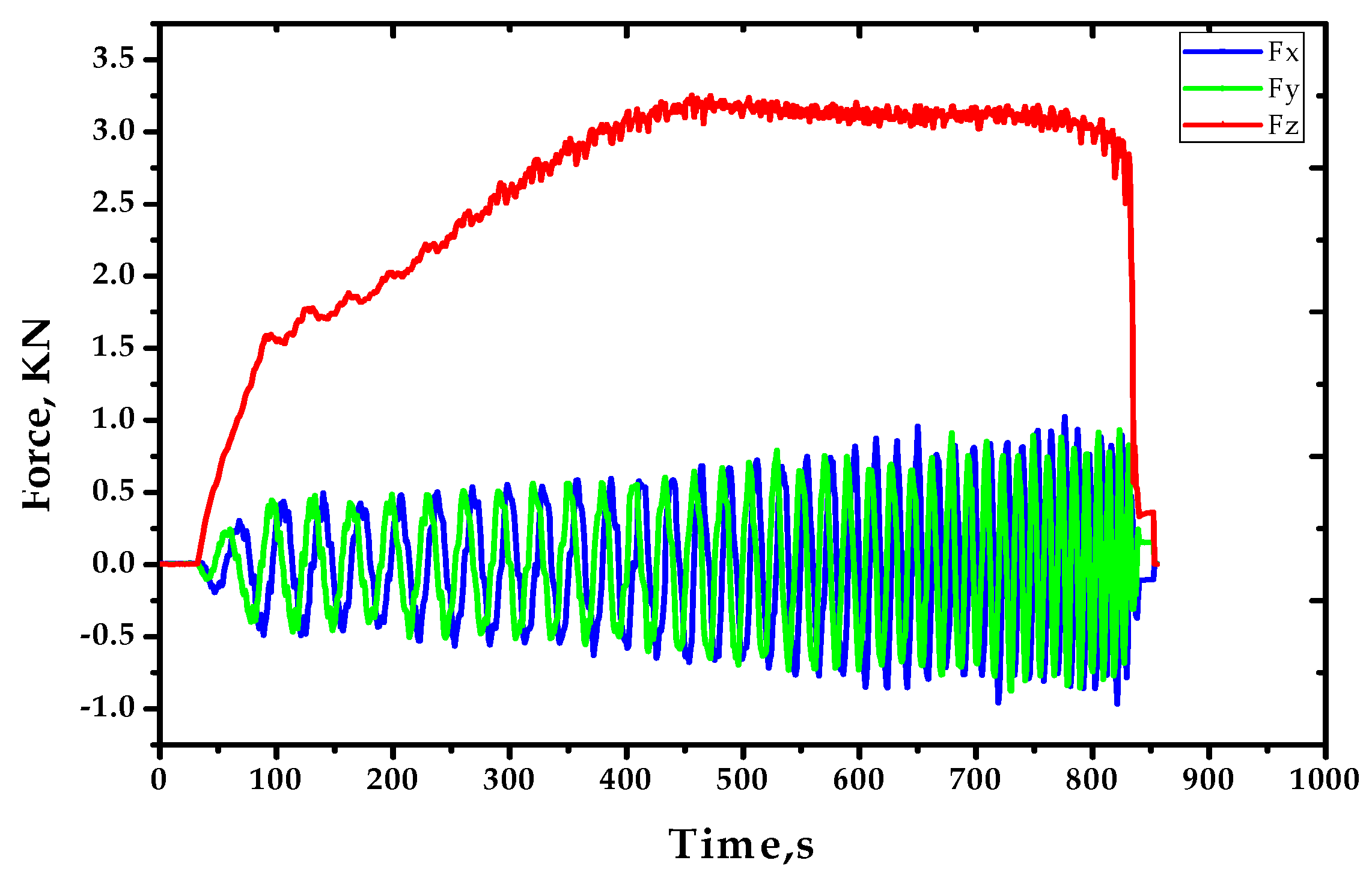
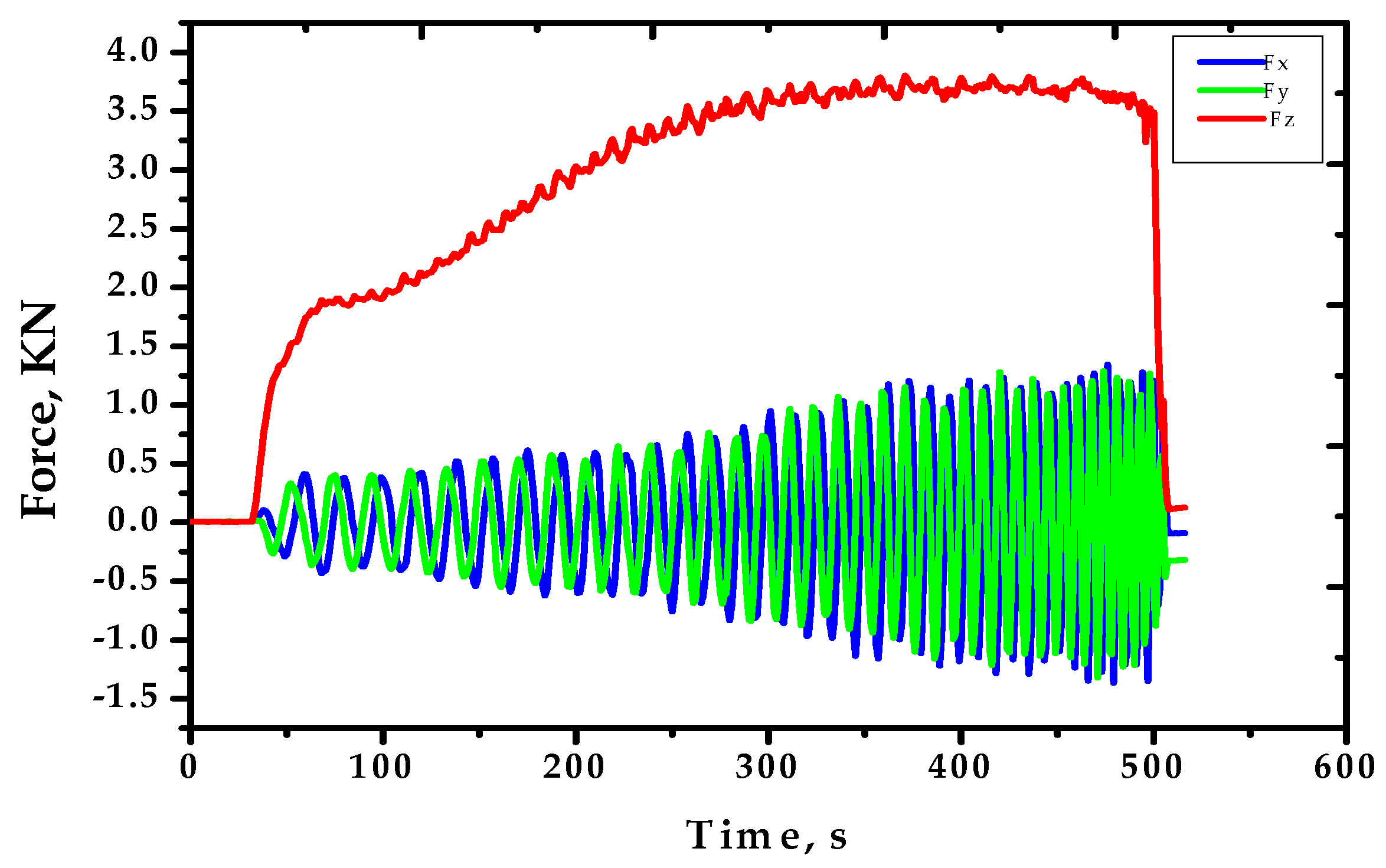
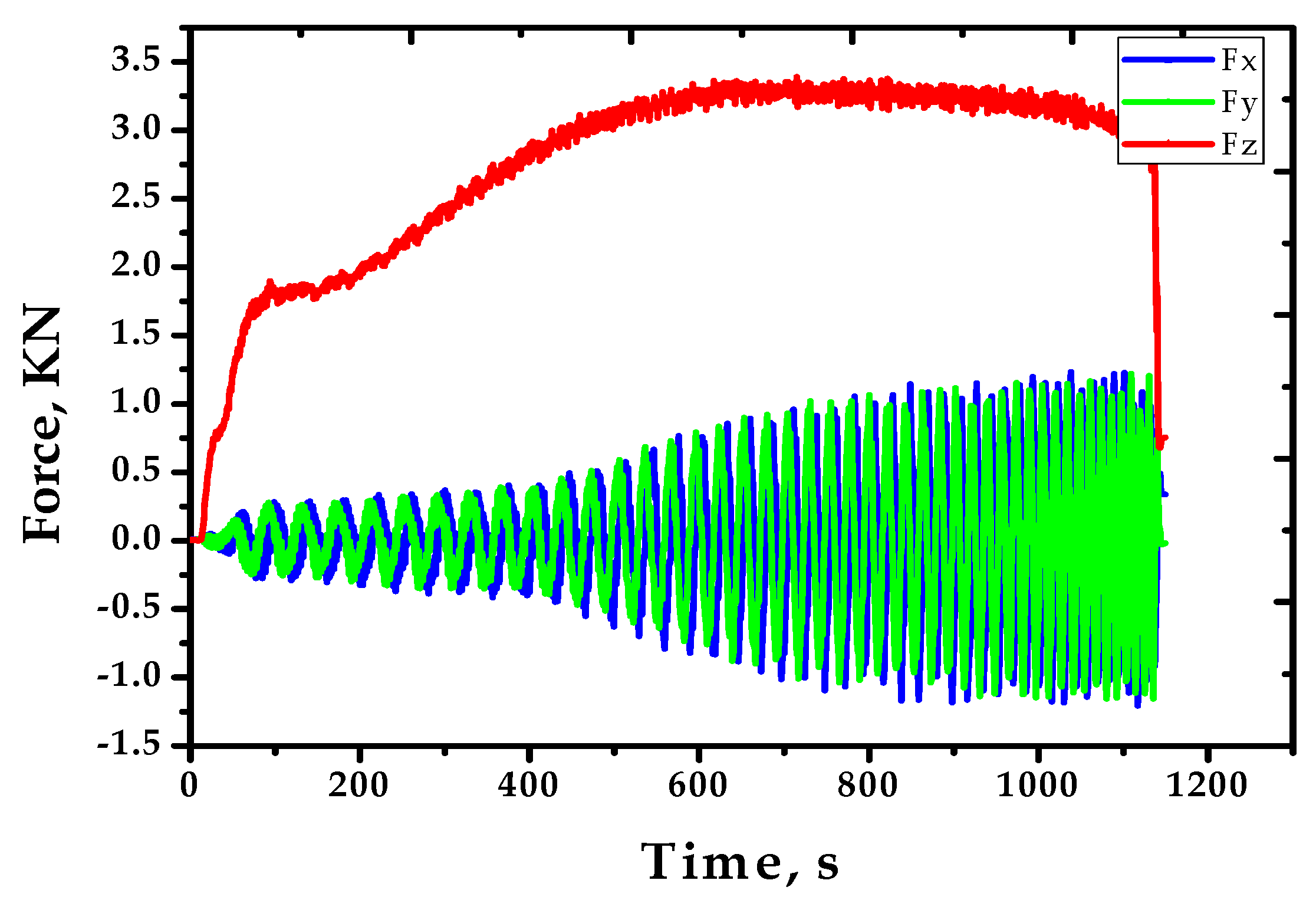
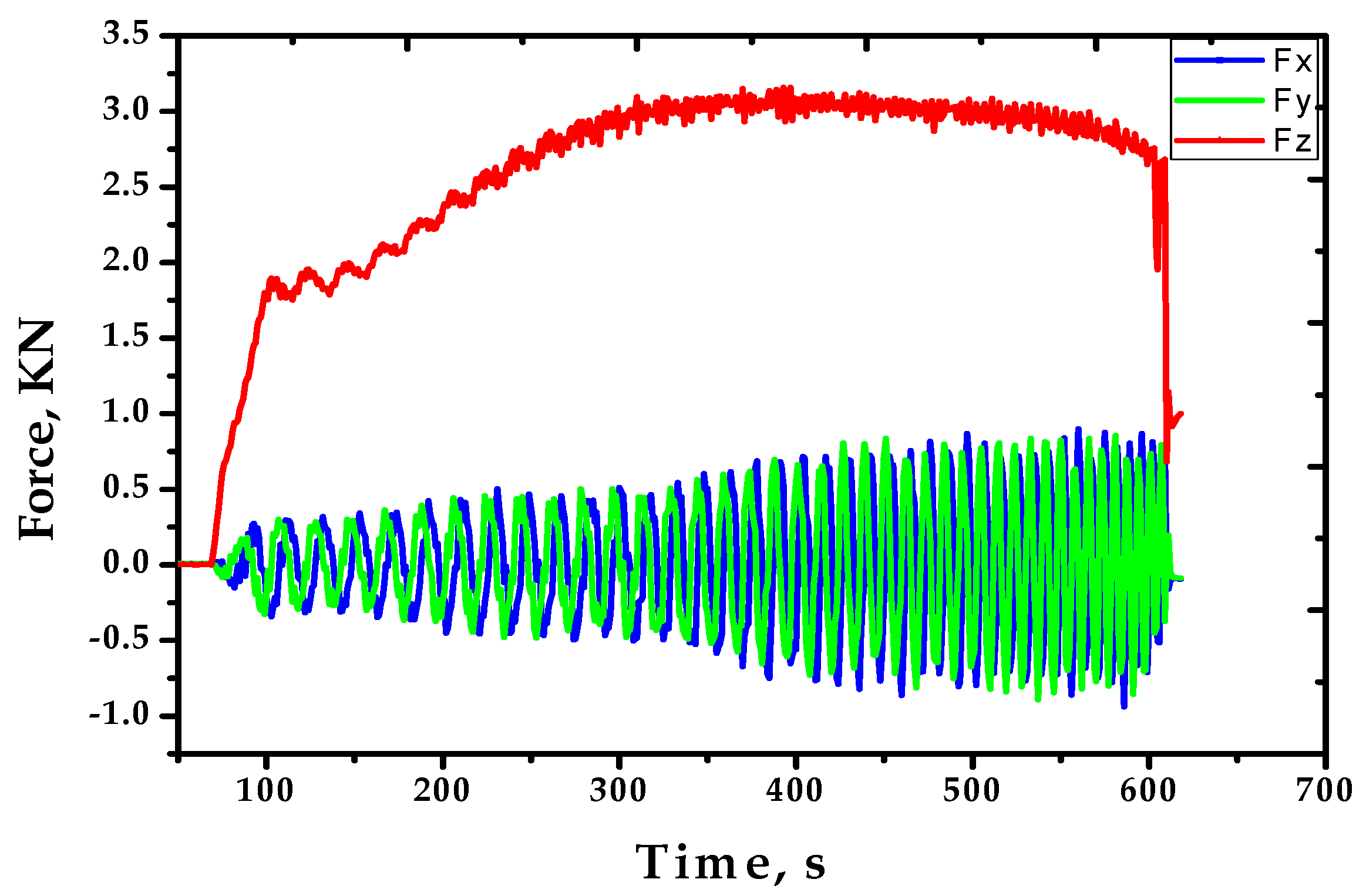
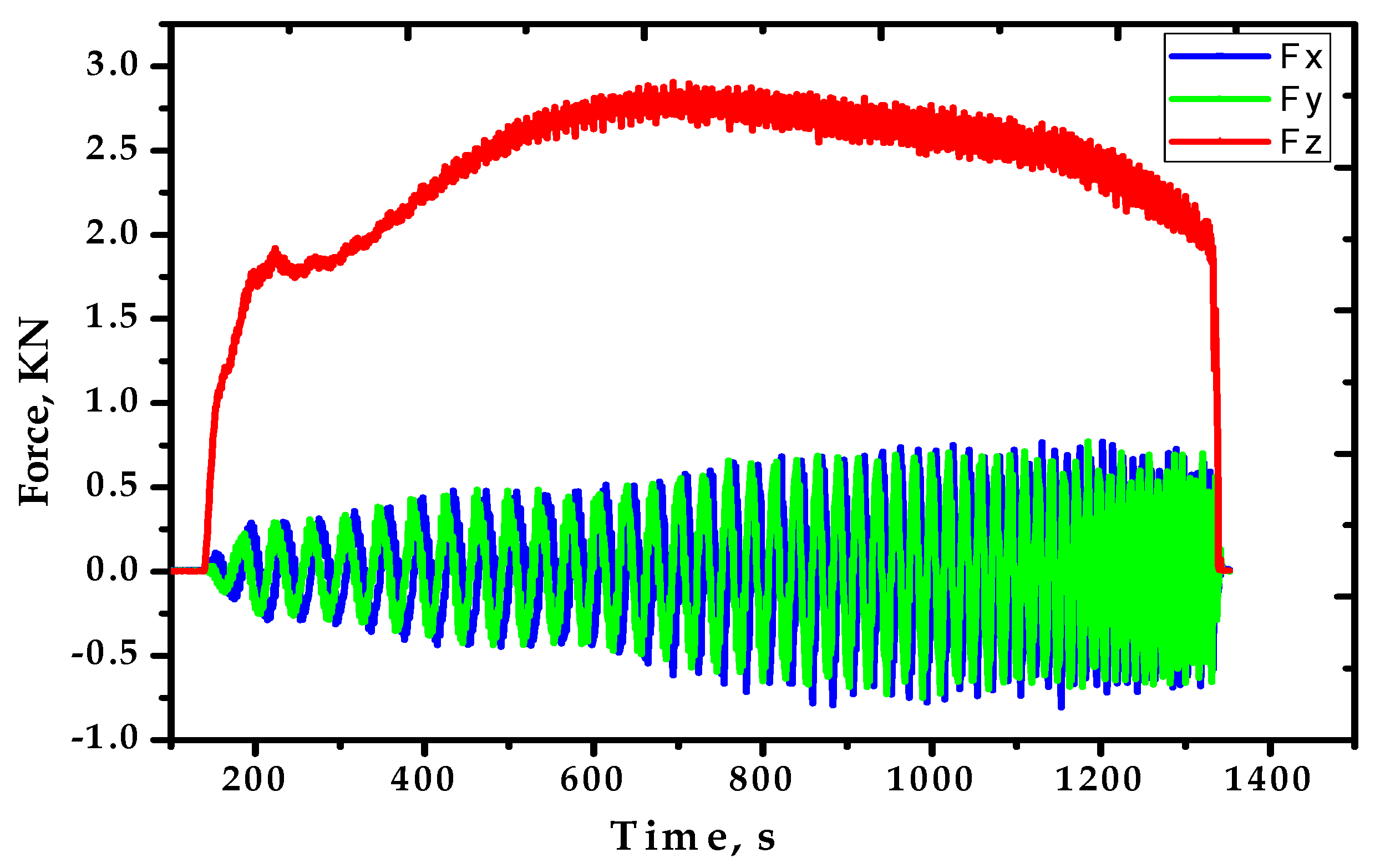
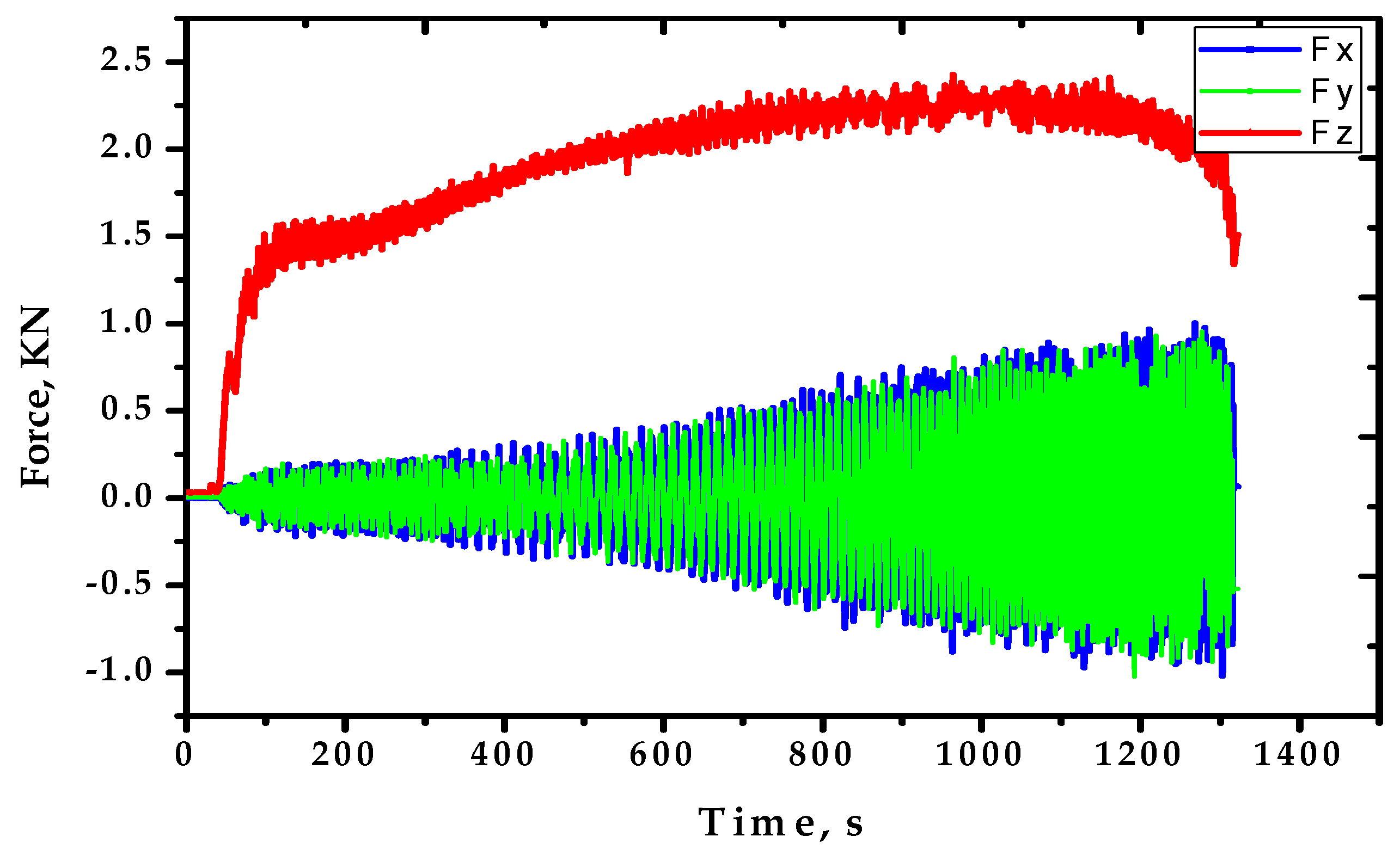
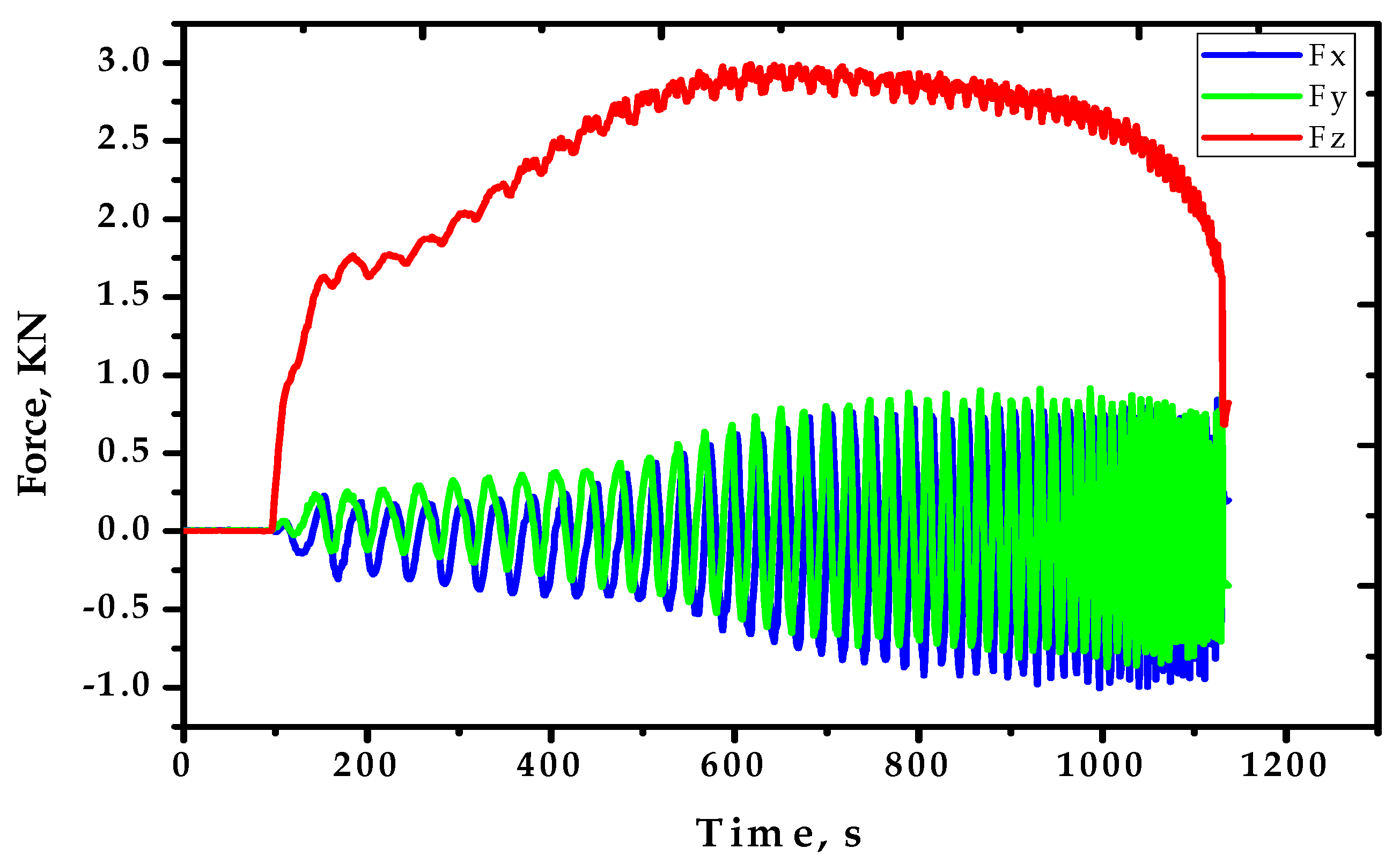
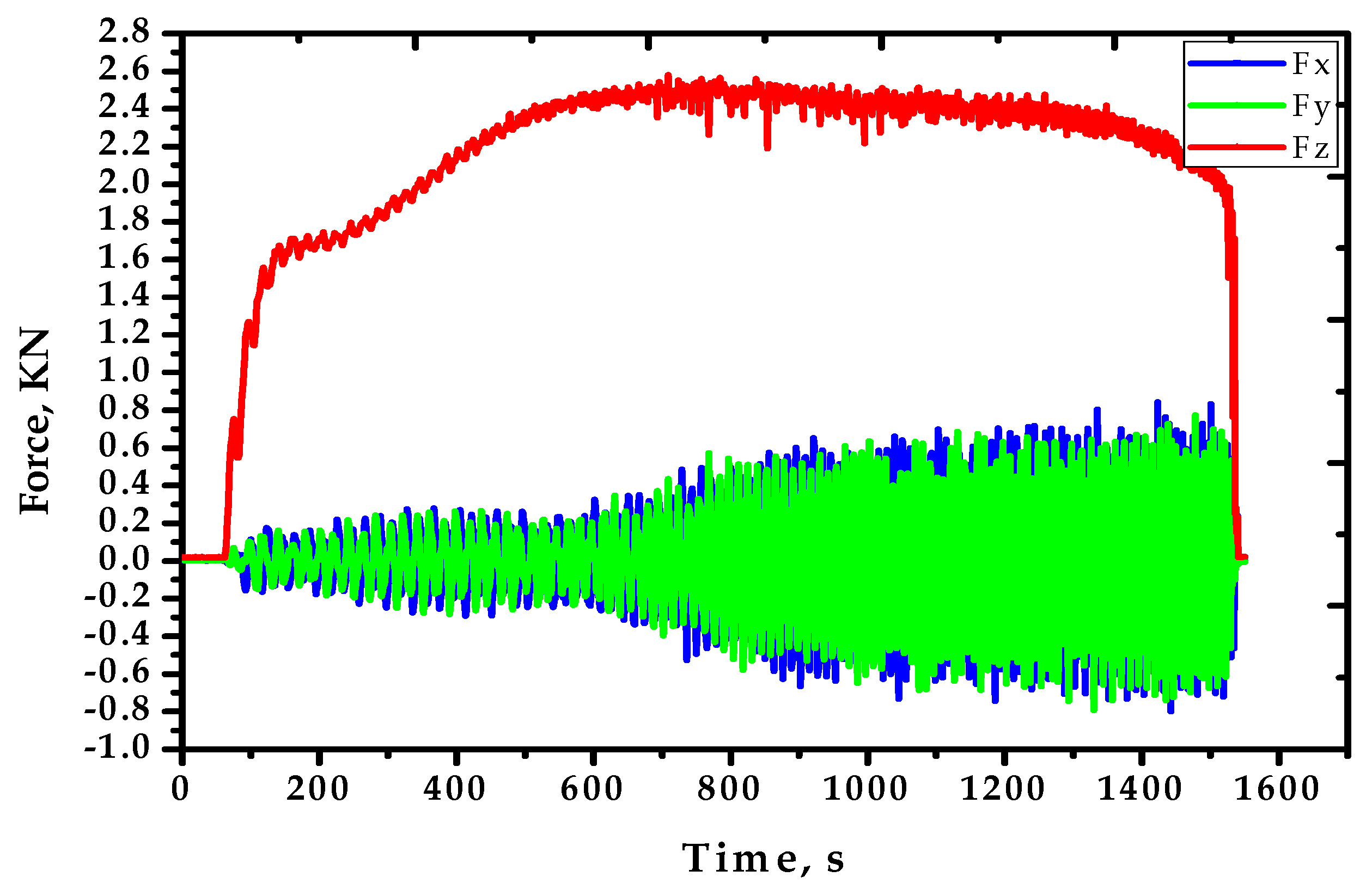
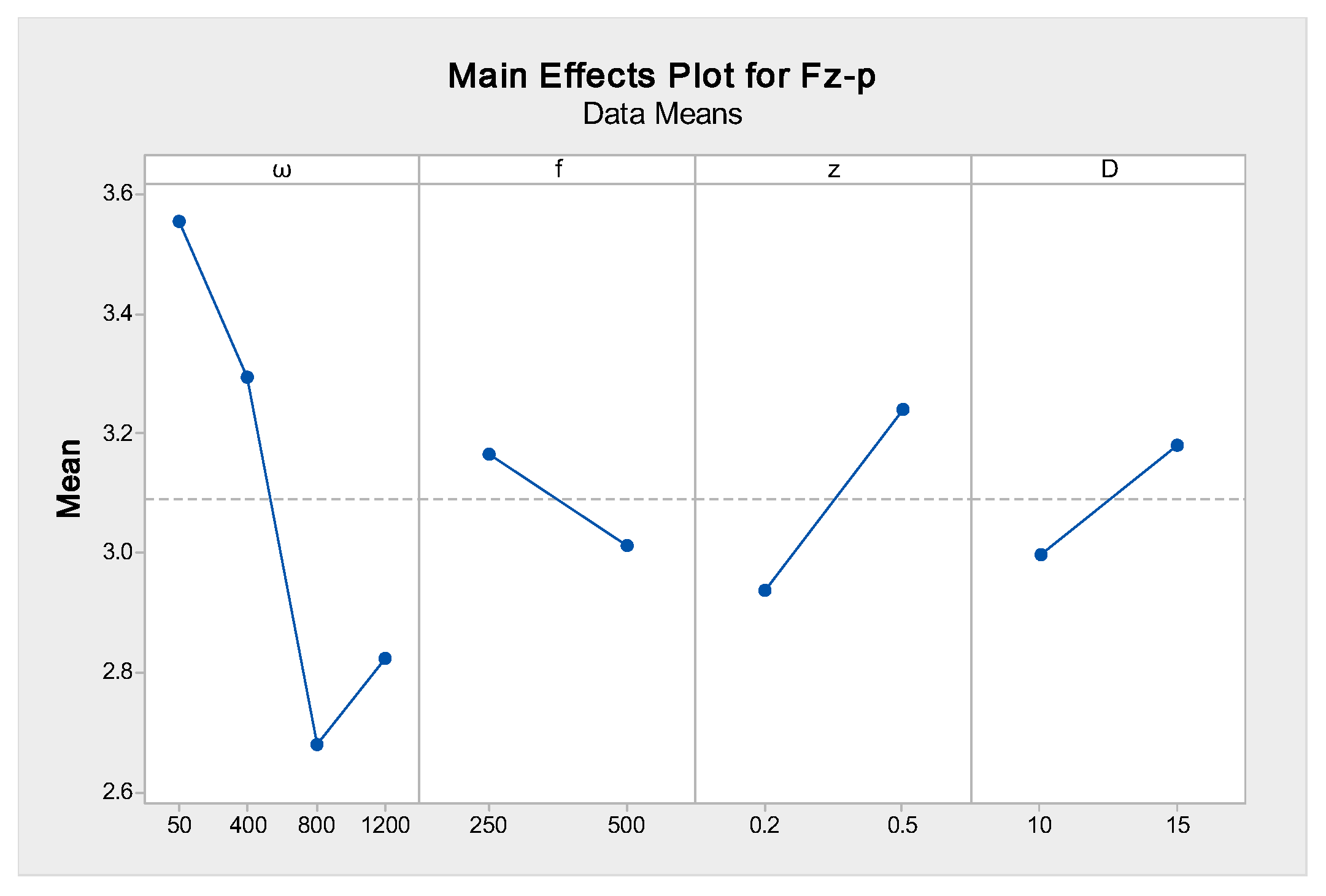
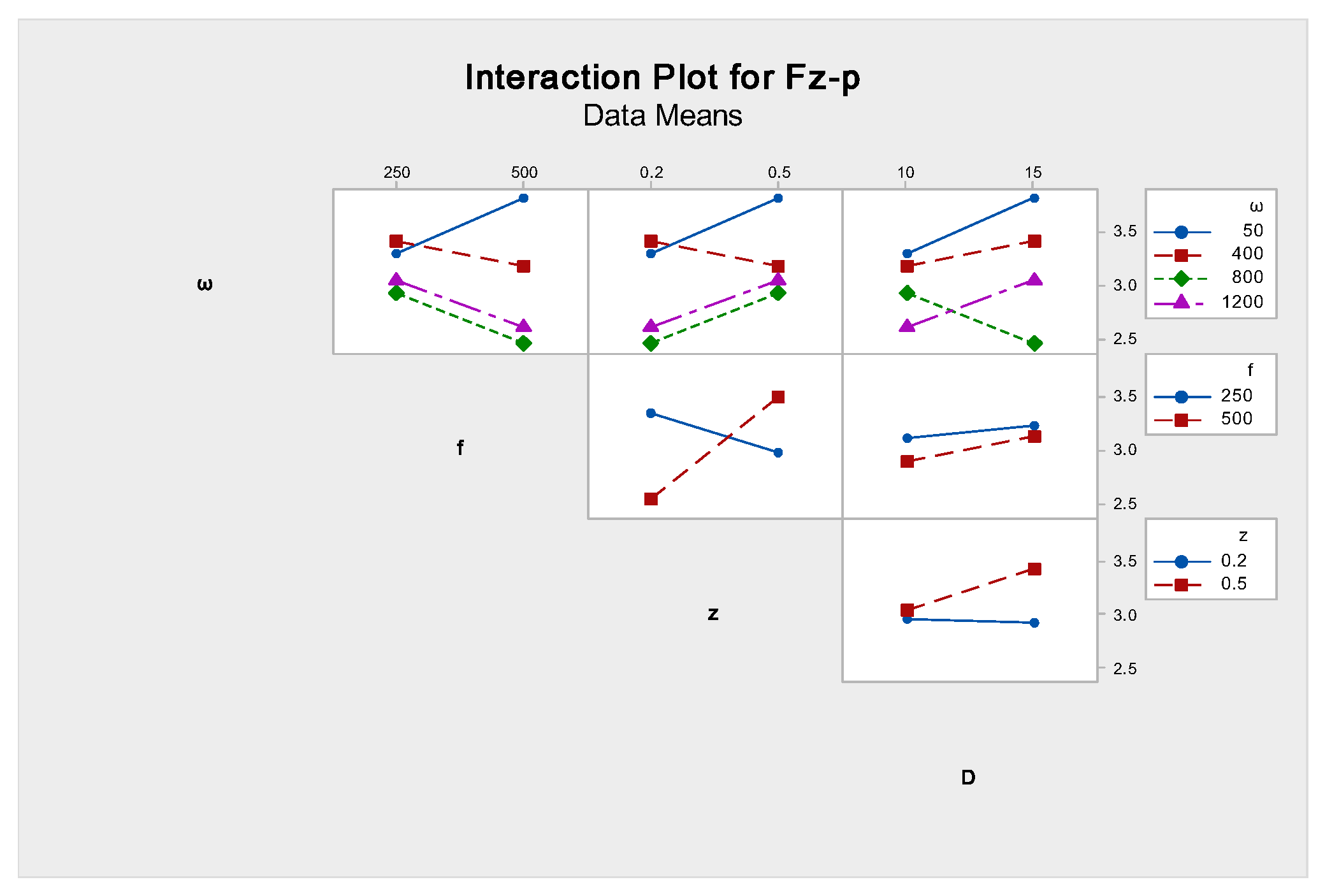

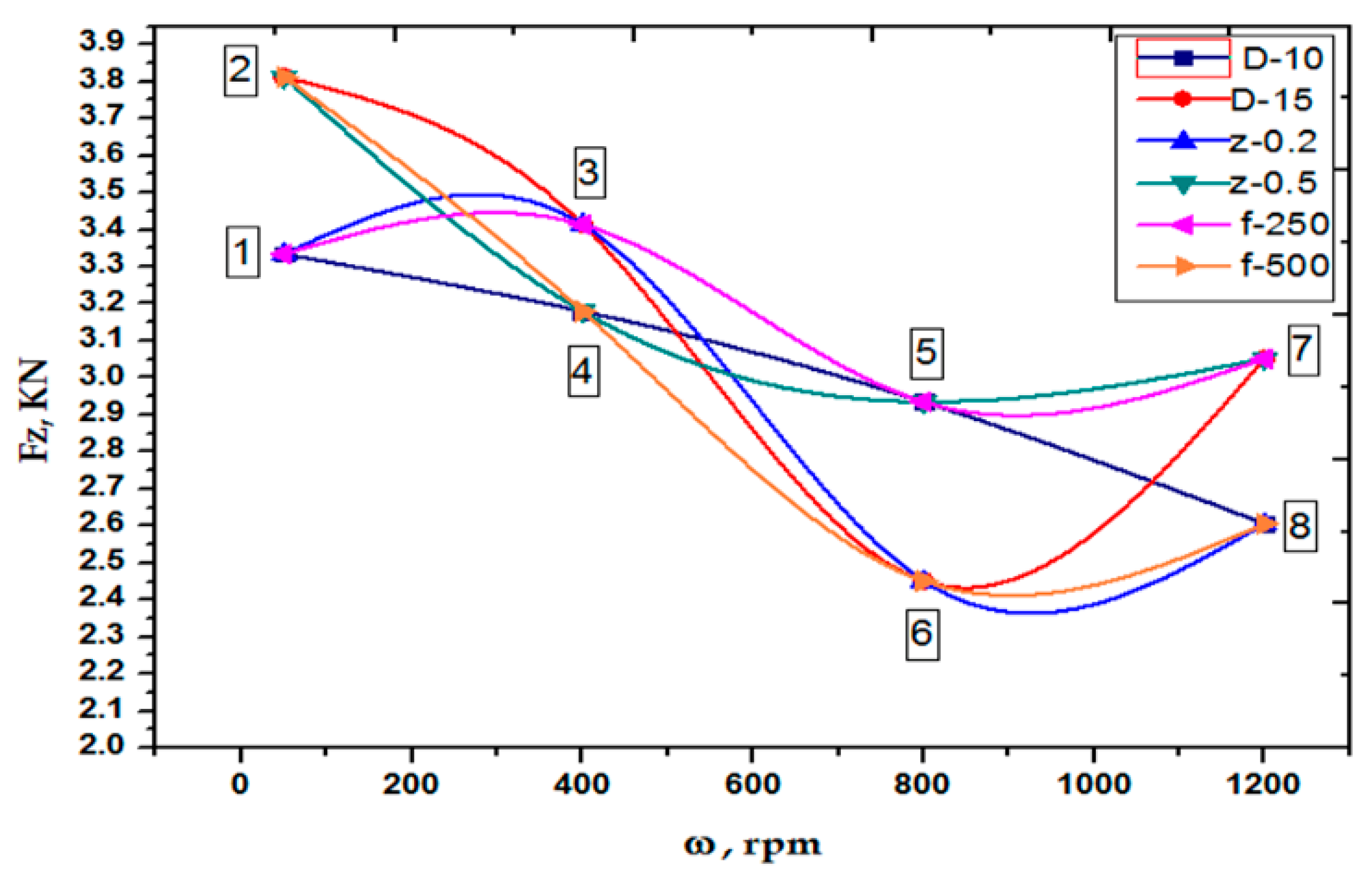
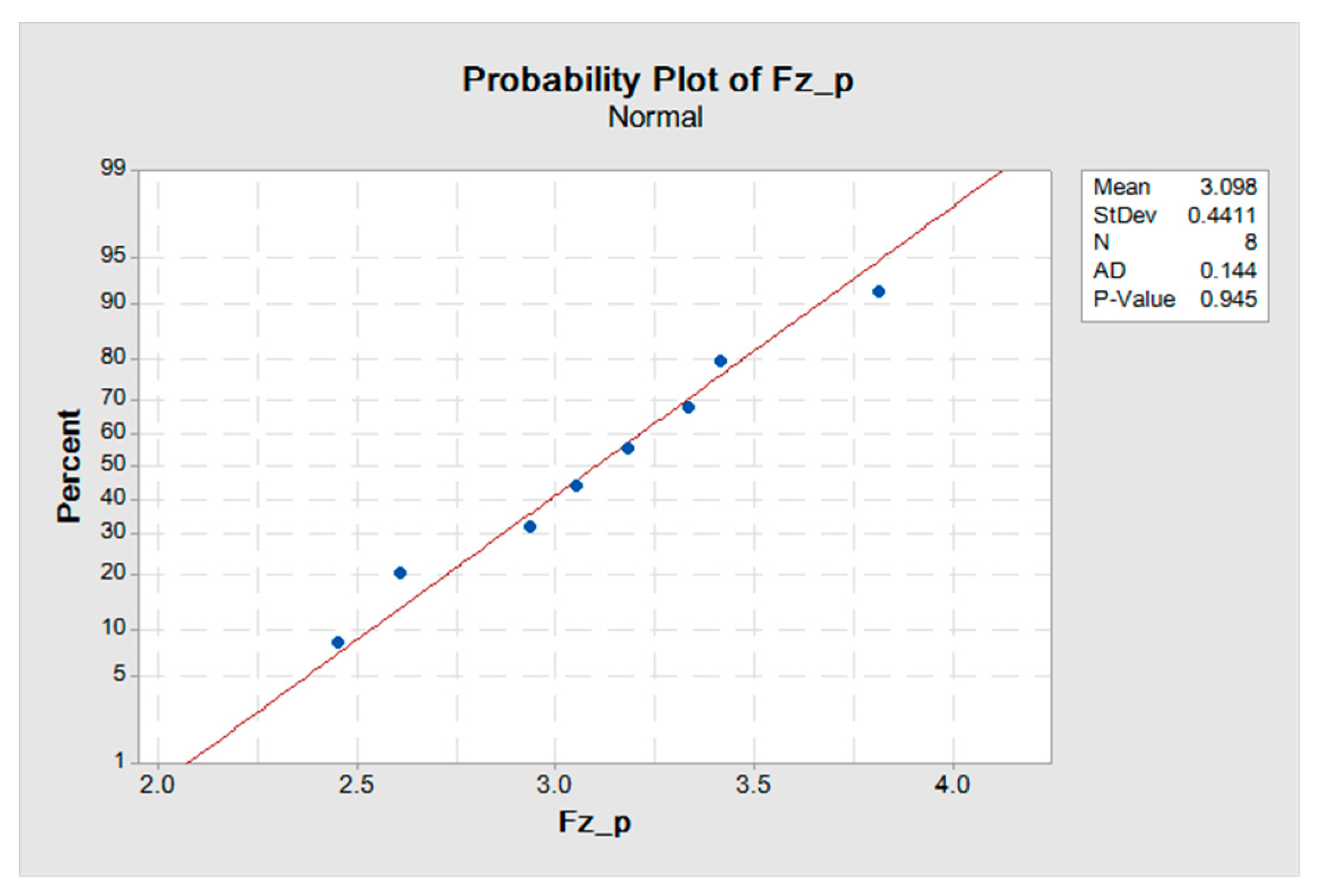
| Material | Si | Fe | Cu | Mn | Mg | Cr | Ni | Zn | Ti | Al |
|---|---|---|---|---|---|---|---|---|---|---|
| AA6061-T6 | 0.52 | 0.19 | 0.27 | 0.07 | 0.91 | 0.1 | - | 0.02 | 0.01 | Bal. |
| Parameter | Description | Level 1 | Level 2 | Level 3 | Level 4 |
|---|---|---|---|---|---|
| ω | Spindle speed (rpm) | 50 | 400 | 800 | 1200 |
| f | Feed rate (mm/min) | 250 | 500 | - | - |
| z | Step size (mm) | 0.2 | 0.5 | - | - |
| D | Tool tip diameter (mm) | 10 | 15 | - | - |
| Run | ω (rpm) | f (mm/min) | z (mm) | D (mm) |
|---|---|---|---|---|
| 1 | 1 (50) | 1 (250) | 1 (0.2) | 1 (10) |
| 2 | 1 (50) | 2 (500) | 2 (0.5) | 2 (15) |
| 3 | 2 (400) | 1 (250) | 1 (0.2) | 2 (15) |
| 4 | 2 (400) | 2 (500) | 2 (0.5) | 1 (10) |
| 5 | 3 (800) | 1 (250) | 2 (0.5) | 1 (10) |
| 6 | 3 (800) | 2 (500) | 1 (0.2) | 2 (15) |
| 7 | 4 (1200) | 1 (250) | 2 (0.5) | 2 (15) |
| 8 | 4 (1200) | 2 (500) | 1 (0.2) | 1 (10) |
| Run | Max. Forces (kN) | Resultant Forces | |||
|---|---|---|---|---|---|
| Fx | Fy | Fz-p | Fxy | FR | |
| 1 | −0.60822 | 0.228577 | 3.29163 | 0.649748 | 3.355145 |
| 2 | 0.997925 | 0.700989 | 3.81836 | 1.219524 | 4.00838 |
| 3 | 0.240784 | 0.896912 | 3.41125 | 0.92867 | 3.5354 |
| 4 | −0.67658 | −0.31189 | 3.18024 | 0.745003 | 3.266337 |
| 5 | −0.19074 | 0.510559 | 2.91534 | 0.545023 | 2.965849 |
| 6 | 0.823669 | −0.08636 | 2.44781 | 0.828184 | 2.584118 |
| 7 | 0.665894 | 0.470276 | 3.04474 | 0.815214 | 3.151986 |
| 8 | 0.238037 | 0.513 | 2.60529 | 0.565536 | 2.665964 |
© 2017 by the authors. Licensee MDPI, Basel, Switzerland. This article is an open access article distributed under the terms and conditions of the Creative Commons Attribution (CC BY) license (http://creativecommons.org/licenses/by/4.0/).
Share and Cite
Baharudin, B.T.H.T.; Azpen, Q.M.; Sulaima, S.; Mustapha, F. Experimental Investigation of Forming Forces in Frictional Stir Incremental Forming of Aluminum Alloy AA6061-T6. Metals 2017, 7, 484. https://doi.org/10.3390/met7110484
Baharudin BTHT, Azpen QM, Sulaima S, Mustapha F. Experimental Investigation of Forming Forces in Frictional Stir Incremental Forming of Aluminum Alloy AA6061-T6. Metals. 2017; 7(11):484. https://doi.org/10.3390/met7110484
Chicago/Turabian StyleBaharudin, B.T.H.T., Q.M. Azpen, Shamsuddin Sulaima, and F. Mustapha. 2017. "Experimental Investigation of Forming Forces in Frictional Stir Incremental Forming of Aluminum Alloy AA6061-T6" Metals 7, no. 11: 484. https://doi.org/10.3390/met7110484





